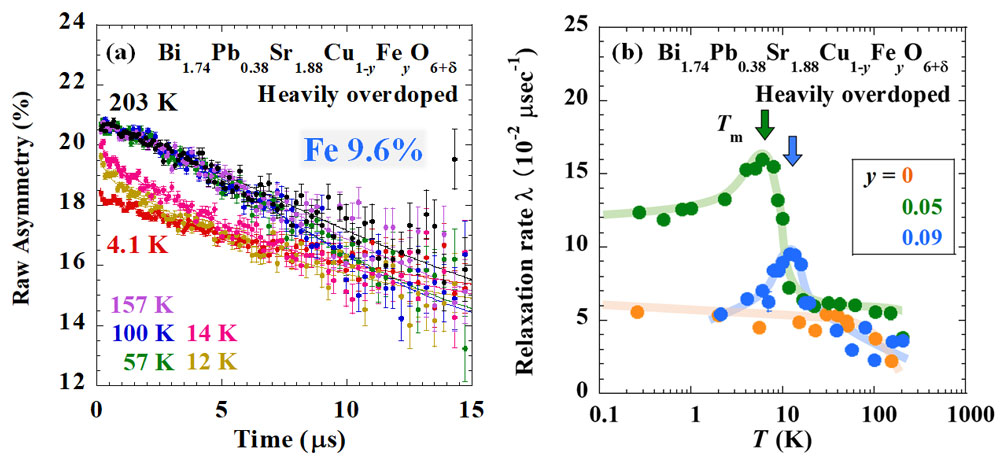PC7-4
Muon Spin Relaxation Study of the Fe-substitution Effects on Ferromagnetic Fluctuations in the Heavily Overdoped Bi-2201 Cuprates
Dec. 1 12:05-12:20
*Yota Komiyama1, Shusei Onishi1, Hideki Kuwahara1, Haruhiko Kuroe1, Koshi Kurashima2, Takayuki Kawamata3, Yoji Koike2, Dita Puspita Sari4,5, Isao Watanabe5, Tadashi Adachi1
Department of Engineering and Applied Sciences, Sophia University, Japan1
Department of Applied Physics, Tohoku University, Japan2
Department of Natural Sciences, Tokyo Denki University, Japan3
College of Engineering, Shibaura Institute of Technology, Japan4
Meson Science Laboratory, RIKEN Nishina Center, Japan5
In the high-Tc cuprate superconductivity, the relationship between antiferromagnetic (AF) spin fluctuations and superconductivity has been extensively studied. It has been suggested that low-energy AF fluctuations disappear concomitant with the suppression of superconductivity in the overdoped regime.1) On the other hand, resonant inelastic X-ray scattering has revealed robust AF fluctuations in the non-superconducting heavily overdoped (HOD) regime.2)
It has been proposed that ferromagnetic (FM) fluctuations exist and are related to the suppression of superconductivity in the HOD regime of high-Tc cuprates.3,4) There are two candidates for the origin of FM fluctuations. One is itinerant electron ferromagnetism due to enhanced spin susceptibility at q ~ (0, 0) and large density of states at the Fermi level.5,6) The other is the double exchange interaction due to the multiband nature of the Cu3dx2-y2 and Cu3d3z2-r2 orbitals suggested by the Compton scattering.7)
Our former studies of the overdoped and HOD Bi-2201 cuprates revealed that FM fluctuations exist and were enhanced by the Fe-substitution.8,9) To further understand the details of FM fluctuations, we performed muon-spin-relaxation (μSR) measurements of Fe-substituted Bi-2201.
Figure (a) shows zero-field μSR time spectra of 9.6% Fe-substituted Bi1.74Pb0.38Sr1.88Cu1-yFeyO6+δ with y = 0.096 in the HOD regime. It is found that fast relaxation and muon-spin precession are observed at 4.1 K, suggesting the formation of a long-range magnetic order. Figure (b) shows the temperatures dependence of the relaxation rate of muon spins λ in HOD Bi1.74Pb0.38Sr1.88Cu1-yFeyO6+δ with y = 0, 0.05, 0.096. It is found that λ is enhanced and exhibits a peak at low temperatures for the Fe-substituted samples. The peak temperature below which the spin-glass state is formed increases with Fe substitution.
For y = 0.096, the internal magnetic field at the muon site is comparable to that reported in the overdoped regime of Bi-2201 in which the AF order is formed around Fe.10) We propose the formation of a cluster spin-glass at low temperatures, in which a short-range magnetic order is formed in a cluster around each Fe and a spin-glass state is formed between clusters in the CuO2 plane. In the clusters, an AF order might be formed according to the overdoped regime.10) On the other hand, based on our results, a FM order might be formed in the cluster.
[1] S. Wakimoto et al., Phys. Rev. Lett. 92, 217004 (2004).
[2] M. P. M. Dean et al., Nat. Mater. 12, 1019 (2013).
[3] A. Kopp et al., Proc. Natl. Acad. Sci. U.S.A. 104, 6123 (2007).
[4] J. E. Sonier et al., Proc. Natl. Acad. Sci. U.S.A. 107, 17131 (2010).
[5] Y. Y. Peng et al., Phys. Rev. B, 98, 144507 (2018).
[6] T. A. Maier and D. J. Scalapino, J. Supercond. Nov. Magn. 33, 15 (2020).
[7] Y. Sakurai et al., Science 332, 698 (2011).
[8] K. Kurashima et al., Phys. Rev. Lett. 121, 057002 (2018).
[9] Y. Komiyama et al., J. Phys. Soc. Jpn. 90, 084701 (2021).
[10] H. Hiraka et al., Phys. Rev. B 81, 144501 (2010).
Figure: (a) Zero-field μSR time spectrum of HOD Bi1.74Pb0.38Sr1.88Cu1-yFeyO6+δ with y = 0.096. (b) Temperature dependence of the relaxation rate of muon spins λ in HOD Bi1.74Pb0.38Sr1.88Cu1-yFeyO6+δ with y = 0, 0.05, 0.096.
Keywords: Ferromagnetic fluctuations, Bi-2201, Heavily overdoped regime, Muon spin relaxation
